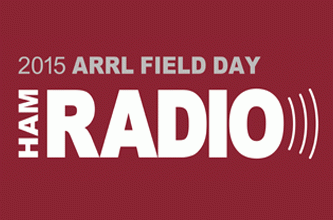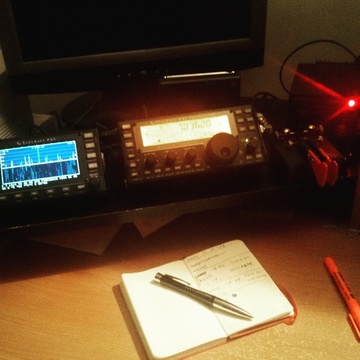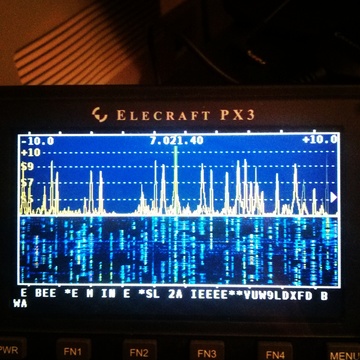ARRL Field Day 2015
It's already been a month since the 2015 ARRL Field Day, so I better get this post up soon or else it will be old news!  The the last few years I've tried to get on the air for some portion of Field Day.  You can read about my 2013 and 2014 experiences on this site.  Each year I try to do things a little different, and this year was no exception.
For those not in the know, Field Day is an annual amateur radio event sponsored by the ARRL to encourage operators to get on the air, and make contact with as many other radio operators as possible. Â People participate for many different reasons. Â Some treat it like a contest, trying to bag the highest score possible. Â Others, use it to test portable or emergency operations. Â And, probably most people who participate just do it for casual fun. Â I'm usually in that last boat even though I have in the past operated on emergency power, for fun.
The event runs a little over 24 hours on the fourth weekend of June.  Last year over 47,000 operators participated!  I would love to operate Field Day for a full weekend, but my spare time these days is scarce, so I'm lucky to carve out a couple of disjointed hours throughout the event to operate.
This year time was especially short, so I decided to operate as a so-called 1D Western Pennsylvania station. Â 1D means I was operating a single person station on commercial power. Â Basically, I just rolled up a chair to my desk and turned the radio on, like I would on any normal day.

My Field Day station setup this year
This year I also wanted to operate 100% CW with my new Begali paddles I picked up at Dayton. Â I've been venturing into more CW operation, making seven CW contacts during the ARRL Centennial Event last year (including my first), and so far bagging one real CW QSO.
Field Day is a great time for novice CW (a.k.a. morse code) operators to get on the air.  The bands can sound intimidating during Field Day.  There is a lot of activity.  People are moving fast and furious.  But, this is the advantage for CW.  The QSO's are short and rhythmic, and there are a ton to choose from.  Here's the checklist: 1) Can you hear a station sending CQ FD (or calling all Field Day Stations)?  2) Can you send your call sign, designator and location (in my case KB3KG 1D WPA)?  3) Can you hear your own call sign if it's sent by an operator responding back to you?  If yes, you can pretty much operate on Field Day.  It of course helps if you can also transcribe everything the station sends back to you.  As they will send their location and designator, or may want you to repeat information.
I'm not shy about saying that as a novice CW operator I'm still relying a bit on the CW decode functionality on my Elecraft KX3. Â Combined with the PX3 panadapter, this is a truly awesome combination on Field Day. Â I'm getting better at decoding CW sent over the air in my head, but some operators are too fast for me. Â Instead of skipping over them or asking them to slow down, I'm using technology to bridge the gap. Â My strategy for Field Day this year was to locate strong signals with the PX3 that the KX3 could easily decode. Â Wait for an opening and then send my call sign. Â (This is known as hunt-and-pounce operation.) Â If I heard them come back to me, I started copying. Â Many operators were going quite fast, so once I heard them send back my call, I did rely on the CW decode a bit.

Wow! Â Look at all those signals packed into 20 kHz!
Some CW purists, would probably pooh-pooh this approach. Â But, I could care less. Â The fact is that I'm now operating on the air with CW, sending at about 18 WPM, and getting better and better at copying. Â If you are in a similar boat, just get on the air. Â The more experience you have with real world QSO's the more proficient and confident you will become. Â Don't have a KX3? Â Download Fldigi, a free application that works with any desktop operating system and can decode digital signals, including CW.
In all, I operated about two hours and bagged 10 contacts. Â The furthest was to California, and I also grabbed a couple in Southern Texas. Â There was an opening on the 15 meter band for a period of time, and I could hear a lot of activity from Southwest U.S. Â I also made contact with W1AW, the ARRL's station. Â 10 contacts in two hours for me is actually pretty good. Â I operate only at low power, so my small signal needs to fight its way through the crowds. Â I did, however, crank up the power on my KX3 to the full 12 watts instead of the 5 watts I usually run.
If you have never participated in Field Day and are an amateur radio operator, try it out next year. Â I'm willing to bet that you will have some fun.
Posted: Jul 29, 2015
Keyword tags: arrlfield daycwradio operating
Recent Posts
Sticky Posts
shortwavetransmitterqrpschematicAM transmitterelectronics500mWarrlfield daycwradio operatingdayton hamventionham radiocrystal radiosteampunkbasicsmatchbox radio1N34 dioderocket radiota7642mk484zn414AM radiomake a radio



